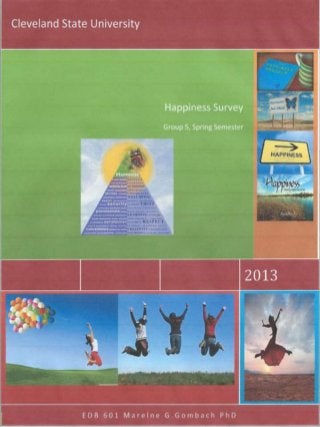
Happiness survey - Final Report, EDB 601, Group 5 - CSU Spring 2013
- 2. Methodology • Our research group created a short ten question survey of open-ended questions regarding what participant felt may define what it means to be happy. The survey was created through an online survey tool called Survey Monkey. We field tested the survey in a pre-sample of ten respondents, two selected from each of our own personal acquaintances. The responses received from our field test elicited results the group felt would be applicable to our final questions. Each researcher distributed the survey electronically by personal and professional e-mails, plus social media sites such as LinkedIn and Facebook. The survey was made accessible to all participants from March 11th through March 19th. Two hundred twenty- seven individuals responded to our electronic survey over the course of one week. Individuals were encouraged to invite others upon receiving our invitation to participate in this survey.
- 3. Demographics • In order to protect anonymity of our respondents, we kept the demographic inquiry to a minimum since we surveyed our own sphere of contacts. Demographic information asked of participants included race/ethnicity, age, gender, income level, and geographic location (zip code). Of the 227 respondents, only 11.4 declined to answer the demographic items. The majority of respondents in our survey were White (82.9%) and Female (70.4%). The age groups of respondents was evenly dispersed between 21 and 60, with the highest percentage of respondents ranging from 21-29 (37.4%). Income levels of our respondents were also evenly dispersed among all ranges with the highest percentage (23.1%) of respondents’ income level being reported approximate household income range being $25K - $49K. Of the 215 participants that offered their zip code, 94 respondents (43%) reported Ohio zip codes. No other zip codes were listed more than half as much as those from Ohio. However, we received participation from zip codes across the entire United States and several foreign countries. We received responses from the Netherlands, The UK, Spain, Chile & Peru.
- 4. Analysis 1. In response to Question 1; What does it mean to be happy?; most respondents defined this as a sense of contentment and fulfillment with regard to home, work, family, and life. 2. In response to Question 2; Who influences happiness?; the majority of responses cited themselves (you, yourself, and oneself) as the major influences of happiness. 3. In response to Question 3; What influences happiness?; the majority of respondents answered with the words of love, commitment to goals, money, actions, health, religion and job in that order. 4. In response to Question 4; When you see the word “Happy”, What are the next three words you think of?; most of respondents answered with the words of joyful, smile, laugh, love, family, peace and content in that order. 5. In response to Question 5; Where do you find happiness?; most respondents said they find happiness in themselves. Home, family, and friends were a close second. In third place came events involving nature (i.e. hiking, outdoors, etc).
- 5. Analysis (cont’d) 6. In response to Question 6; What three material things make you happy?; the majority of responses related that being at home made them happy. Other suggestions were: Disney, his or her workforce, outdoors, vacation house, or Disney. Money was highly interpreted in most individual’s lives, along with material items, such as clothing and accessories (jewelry and shoes). 7. In response to Question 7; What locations make you happy?; the majority of respondents answered with words of home, being outdoors, being near water and being with Family, in that order. The idea of being someplace that invoked a sense of contentment was a common theme in responses to this question. 8. In response to Question 8; What life events reflect happiness?; an overwhelming number of responses had to do with Weddings/Anniversaries and Births/Birthdays. Other themes that were strong were accomplishments such as graduations and promotions with family gatherings rounding out the top 5. Connecting with people was also a common theme in responses to this question. 9. In response to Question 9; How can you tell if someone else is happy?; a large number of answers addressed the act of smiling, body language, and facial expressions. 10. In response to Question 10; How do you show happiness?; the majority of respondents answered with a smile, body language, or laughter.
- 6. Conclusion The answer to our overarching question, and the purpose of our survey, ‘What does it mean to be happy?’, Seems to be that the respondents are happy when they feel content, fulfilled and connected in or at a warm safe place that creates joy.
